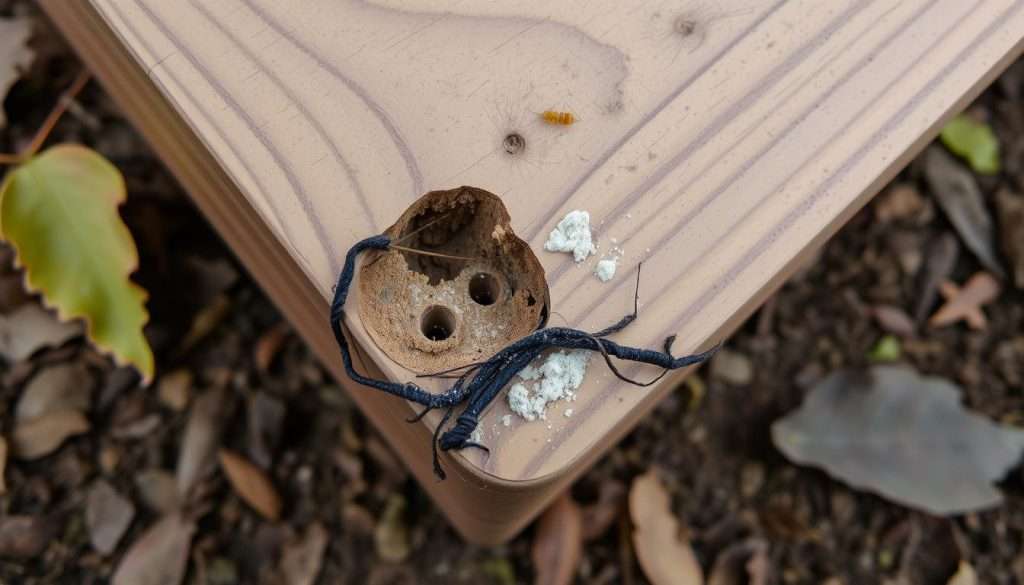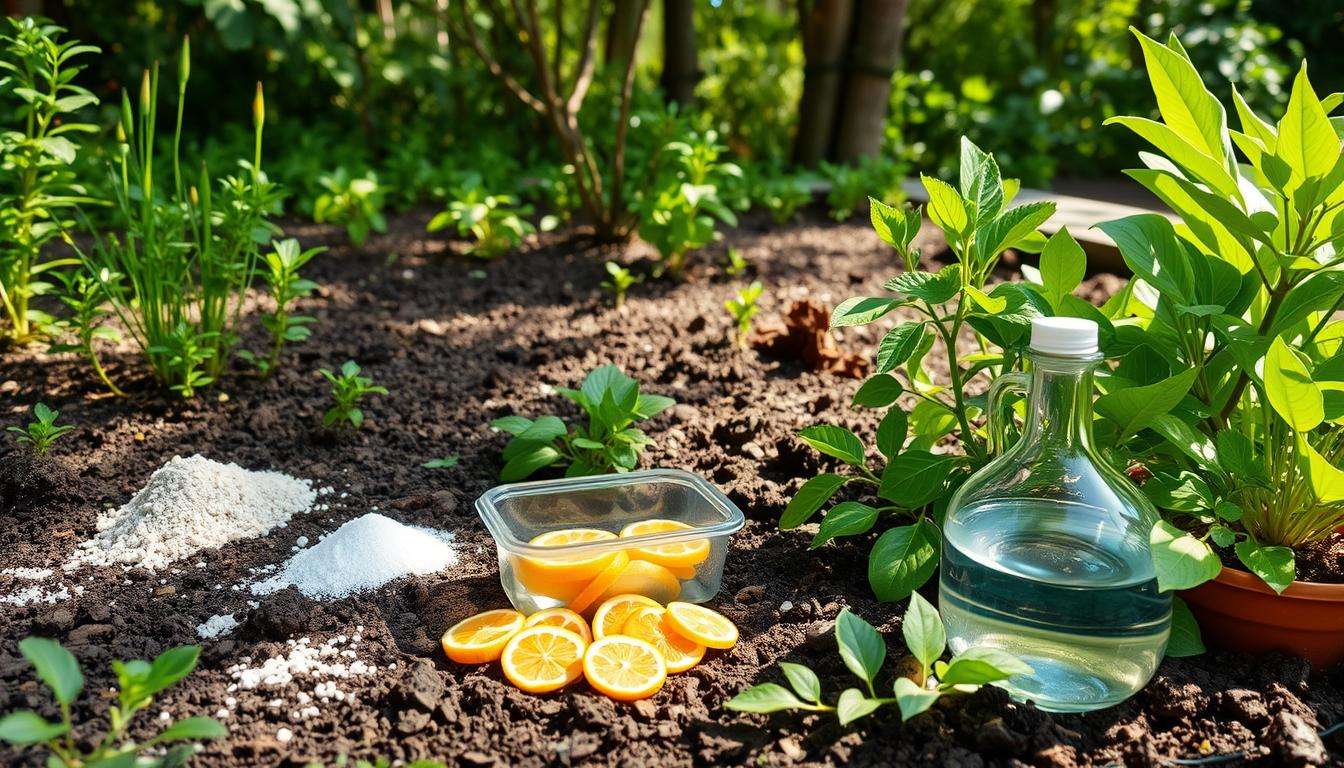Termite infestations are a homeowner’s worst fear. These pests can damage your home’s structure. This can lead to expensive repairs if not treated quickly. Learning how to kill termites naturally is key to keeping your home safe and eco-friendly.
In this guide, we’ll share natural termite control methods. You’ll learn how to use boric acid and make homemade traps. These DIY methods will help you fight termite infestations effectively.
Key Takeaways
- Identify the signs of termite infestations, such as discolored drywall and hollow-sounding wood.
- Boric acid serves as a key natural pesticide that targets termites effectively.
- Creating cardboard traps can lure and eliminate termites when applied consistently.
- Natural nematodes act fast against termites without posing risks to humans or pets.
- Diatomaceous earth dehydrates termites, making it a safe, indoor, and outdoor solution.
- A vinegar and lemon juice spray can be applied to affected areas for immediate effects.
- Reducing moisture levels in your home is crucial to prevent future infestations.
Understanding the Threat of Termites
Termites are small insects that eat wood. They help break down dead trees and plants. But, they can cause a lot of damage before anyone notices.
Knowing about different termites and how they act is key to fighting them.
What are Termites?
Termites live in big groups, sometimes with thousands of members. They eat wood, paper, and other cellulose materials. With over 2,600 termite species worldwide, it’s important to know which ones are a threat to your home.
In the U.S., termites cause about $30 billion in damage each year. They can damage your home’s structure before you even know they’re there.
Types of Termites Affecting Homes
In California, at least 23 termite species can harm homes. The most common types are:
- Subterranean Termites: These termites live in the ground and can get into homes through the soil. Reticulitermes is a common species in California.
- Drywood Termites: Found mainly in southern California, they live in wood. They are hard to deal with, especially in humid areas.
- Dampwood Termites: They like cool, moist places along the coast. They target damp or rotting wood. Spotting their activity is crucial for control.
Knowing about these termites helps us understand their behavior and the damage they can do. Catching them early and taking action can protect your home.
Signs of Termite Infestation
Spotting termites early can save your home from big damage. Knowing the signs is key for homeowners. Learning about signs of termite infestation helps you act fast.
How to Identify Termite Activity
Look for these signs to spot identifying termite activity:
- Mud Tubes: Subterranean termites make thin tunnels.
- Flying Swarms: Seeing winged termites or shed wings means trouble.
- Damaged Wood: Look for wood that’s blistered or dark and breaks easily.
- Bulging Floors, Ceilings, or Walls: This could mean Formosan termites are around.
- Holes and Droppings: Pinholes with tiny pellets are signs of drywood termites.
- Audible and Odor-Producing Clues: Listen for clicks and smell a musty smell.
Damage Caused by Termites
Ignoring termite damage signs can cause big problems. Termites can harm wooden beams, making your home unsafe. Knowing the risks helps you fix problems before they get worse.

| Termite Type | Preferred Environment | Colony Size |
|---|---|---|
| Subterranean Termites | High humidity, moist wood, near foundations | Hundreds of thousands to 1 million |
| Formosan Termites | Southeast, Southern California, Hawaii | Up to several million |
| Drywood Termites | Gulf Coast, Southwest, anywhere in house | Small colonies, independent of ground contact |
When to Use Natural Methods of Termite Control
Natural termite control is a good choice for homeowners with termite problems. It works best for small infestations. For these, you can use vinegar, boric acid, or nematodes.
But for big infestations, you might need a pro. They can give you the right treatment.
Assessing the Scale of Infestation
Look for signs to see how bad the infestation is. Check for:
- Drywall discoloration and paint peeling, which can indicate hidden damage.
- Squeaky floorboards that may result from compromised structural integrity.
- Termite droppings and wings which hint at active colonies.
- Mud tubes on walls or the foundation, essential for their transport between nests and food sources.
Knowing these signs helps you choose the right action. You might use natural remedies or call a pro. For example:
- Natural remedies like boric acid stop termites from eating, killing them.
- Nematodes target termites without harming people or pets.
- Vinegar mixed with lemon juice is a simple way to get rid of termites.
If the damage is big or the infestation is everywhere, call a pro. Varsity Termite and Pest Control can help. They offer safe and effective treatments.
How to Kill Termites Naturally
Homeowners often look for natural ways to fight termites. Knowing the different natural termite control methods helps you choose the right one. Here are some effective options and a look at DIY methods versus professional treatments.
Natural Remedies for Termite Control
There are many natural ways to kill termites. These methods use nature’s power to fight termites safely and effectively:
- Boric Acid: Works well on dry wood termites. It has antibacterial properties that fight termite infestations.
- Diatomaceous Earth: This safe solution dries out termites. Sprinkle it in areas where termites are found.
- Nematodes: A 2006 study in the Journal of Economic Entomology shows these tiny worms are great at killing termites.
- Cardboard Bait Systems: Used mainly for subterranean termites, these traps can catch and kill them.
- Orange Oil: This oil, with d-limonene, dries out termites when applied to infested wood.
- Neem Oil: It stops termites from molting and reproducing, making it a good natural solution.
- Vinegar: Vinegar’s acidity can kill termites by breaking their exoskeleton. But, its success depends on the concentration.
- Cayenne Pepper: This spice is said to be a natural killer of termites.
Comparing DIY Solutions to Professional Treatments
When deciding between DIY termite removal and professional treatments, consider these points:
| Aspect | DIY Solutions | Professional Treatments |
|---|---|---|
| Cost | Usually cheaper; you can find supplies at supermarkets | More costly; prices vary with the treatment’s extent |
| Effectiveness | May not work well for a full infestation | More effective and gives long-term results with expert application |
| Health Risks | Can be risky for humans, pets, and plants if not used right | Less risk with proper chemical use by trained exterminators |
| Convenience | Can fit your schedule; you can act fast | Requires scheduled appointments; a professional assessment is needed |
Using natural remedies for termite control is often a cost-effective and quick fix. Knowing your situation helps you pick the best method. It’s about finding a balance between cost and effectiveness.

Homemade Solutions for Termite Elimination
Looking for ways to get rid of termites without spending a lot? There are many homemade solutions. Using boric acid for termites, nematodes, and homemade baits can help. These methods are safer and cheaper than harsh chemicals.
Using Boric Acid for Termite Control
Boric acid, found in Borax, kills termites by stopping them from getting nutrients. Mix it with sugar and water to make a paste. Put it where termites are seen.
This method is safe for people and pets. It’s a good way to fight termites without harming others.
The Effectiveness of Nematodes
Nematodes are tiny worms that eat termites. They can be used to control termites. Mix them with water and spray where termites are found.
This method is good for the environment. It helps keep your home healthy and natural.
Cardboard Bait System Explained
The cardboard bait system uses termites’ love for cellulose. Soak cardboard and put it where termites are seen. Termites will go to the cardboard, making it easy to catch them.
This method works for small problems. But, use it with boric acid for better results. For more DIY termite tips, check out this link.
Eco-Friendly Termite Treatment Options
Dealing with termites can be tough. You might want solutions that are safe for your home and the planet. Eco-friendly termite solutions use natural products to control pests. They are less harmful to our ecosystems.
We will look at two main methods: diatomaceous earth and orange oil for termite removal.
Diatomaceous Earth and Its Usage
Diatomaceous earth is a non-toxic way to fight termites. It’s made from fossilized algae. Its abrasive nature makes it effective.
Here’s how to use it:
- Find where termites are active.
- Spread a thin layer of diatomaceous earth on trails and entry points.
- Put it back after rain or cleaning to keep it working.
The sharp particles in diatomaceous earth harm insects. They cause dehydration and death. It also keeps other pests away, making it great for eco-friendly pest control.
Benefits of Orange Oil in Termite Removal
Orange oil, made from orange peels, is a strong ally against termites. It has d-limonene, which stops termites from breeding. It’s safe for humans and pets.
Here are its benefits:
- Works well on small infestations.
- Acts fast when termites touch it.
- Leaves a nice citrus smell, unlike harsh pesticides.
To use orange oil, apply it directly to affected areas. Or mix it with water for more coverage. It’s best for small infestations.
Using diatomaceous earth and orange oil in pest control helps you live sustainably. It also keeps your home safe from termites.
Preventative Measures Against Termite Infestations
Preventing termites is key to keeping your home safe. Regular checks are very important. They help find problems early. Let’s look at how to keep your home safe from termites.
Inspecting Your Home Regularly
Knowing how to check your home for termites is crucial. Here are some tips:
- Look for mud tubes and droppings, signs of termites.
- Check wooden parts like beams and furniture for damage.
- Moist areas attract termites, so check them closely.
- Make sure crawl spaces and attics have good air flow.
- Use a flashlight to see dark spots where termites like to hide.
Best Practices to Keep Your Home Termite-Free
Using the right methods is key to keeping termites away. Here are some tips:
- Keep wood away from your home’s foundation to stop termites.
- Seal cracks in walls and foundations to block termites.
- Fix leaks and ensure good drainage to control moisture.
- Use natural products like orange oil or diatomaceous earth to keep termites away.
- Apply boric acid in areas where termites are common.
Using these methods can greatly lower the chance of termites. A bit of effort now can save you a lot of money later.
Conclusion
Termites can be a big problem for your home. But, using natural termite control methods can help you fight back. We’ve talked about ways to get rid of termites and found eco-friendly options.
Acting fast can save you a lot of trouble and money. It’s important to check your home often and take steps to prevent termites.
While natural methods are great, knowing when to call a pest control expert is key. Keeping your home safe from termites keeps you calm and protects your property.
